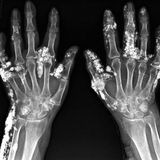


Laser tattoo removal gone wrong!⚠️
Tattoos consist of thousands of large particles of pigment suspended in the skin. Laser tattoo removal is based on successful application of the theory of selective photothermolysis. Q switched laser delivers energy in an ultra-short duration, typically in nanosecond range with very high peak power. This energy is then selectively absorbed by tattoo ink because of its preferential wavelength and thermal relaxation time. The surface temperature of the ink particles can rise to thousands of degrees but this energy profile rapidly collapses into a shock wave. This shock wave then propagates throughout the local tissue (the dermis) causing brittle structures (tattoo pigment) to fragment and leads to vibrational damage to cellular structures and rupture of cell membranes. Like many procedures, side effects are possible post-treatment. Common side effects of laser tattoo removal are frosting, scabbing, swelling, discomfort, itching, hypo- and hyperpigmentation and blistering. Blisters after laser tattoo removal sessions are often caused by the laser heating up the ink particles in your skin which can then cause blood vessels surrounding the tattoo area to break. Therefore, blisters containing ink, blood and water may appear on your skin.


